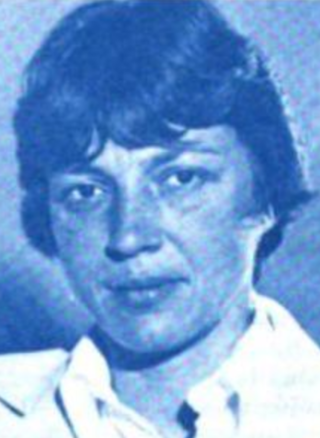
The Swedish Vacuum Solar Telescope was a 47.5 cm solar telescope on La Palma in the Canary Islands. It was removed on 28 August 2000, and has been superseded by the Swedish 1-m Solar Telescope.

Joan Feynman was an American astrophysicist and space physicist. She made contributions to the study of solar wind particles and fields, sun-Earth relations, and magnetospheric physics. In particular, Feynman was known for developing an understanding of the origin of auroras. She was also known for creating a model that predicts the number of high-energy particles likely to hit a spacecraft over its lifetime, and for uncovering a method for predicting sunspot cycles.

The European Physical Society (EPS) is a non-profit organisation whose purpose is to promote physics and physicists in Europe through methods such as physics outreach, supporting physicists to engage in the design and implementation of European science policy, and advocating physics research. Formally established in 1968, its membership includes the national physical societies of 42 countries, and some 3200 individual members. The Deutsche Physikalische Gesellschaft, the world's largest and oldest organisation of physicists, is a major member.

The Carrington Event was the most intense geomagnetic storm in recorded history, peaking on 1–2 September 1859 during solar cycle 10. It created strong auroral displays that were reported globally and caused sparking and even fires in telegraph stations. The geomagnetic storm was most likely the result of a coronal mass ejection (CME) from the Sun colliding with Earth's magnetosphere.

The Leibniz Institute for Solar Physics (aka: KIS; German: Leibniz-Institut für Sonnenphysik), formerly known as Kiepenheuer Institute for Solar Physics (KIS) is a research institute located in Freiburg, Germany. As a member of the Leibniz Association, the institute conducts basic research in astronomy and astrophysics with a particular focus on solar physics. The institute's structure and operation is based on three strategic pillars: 1) fundamental research, 2) operation of the German solar telescope infrastructure on Tenerife, and 3) applied research in data science and operation of the Science Data Center. Institute's Professors appointed and habilitated at the University of Freiburg offer lectures at various university degree levels and train young scientists.

Lucinda "Lucie" May Green is a British science communicator and solar physicist.
Angioletta Coradini was an Italian astrophysicist and planetary scientist.

Exobiology Radiation Assembly (ERA) was an experiment that investigated the biological effects of space radiation. An astrobiology mission developed by the European Space Agency (ESA), it took place aboard the European Retrievable Carrier (EURECA), an unmanned 4.5 tonne satellite with a payload of 15 experiments.
MUSE is a European proposal for a dedicated mission to the planet Uranus to study its atmosphere, interior, moons, rings, and magnetosphere. It is proposed to be launched with an Ariane 6 in 2026, travel for 16.5 years to reach Uranus in 2044, and would operate until 2050.

The Community of European Solar Radio Astronomers (CESRA) is a non-profit informal organization of European scientists whose aims are to promote studies of solar radio physics and related topics.

Space climate is the long-term variation in solar activity within the heliosphere, including the solar wind, the Interplanetary magnetic field (IMF), and their effects in the near-Earth environment, including the magnetosphere of Earth and the ionosphere, the upper and lower atmosphere, climate, and other related systems. The scientific study of space climate is an interdisciplinary field of space physics, solar physics, heliophysics, and geophysics. It is thus conceptually related to terrestrial climatology, and its effects on the atmosphere of Earth are considered in climate science.

Eckart Marsch is a German theoretical physicist, who worked from 1980 to 2012 at the originally named Max Planck Institute for Aeronomy, from 2004 on named Max Planck Institute for Solar System Research (MPS) in Katlenburg-Lindau on the physics of the solar wind, solar corona and space plasmas and taught at the University of Göttingen.

Sarah E. Gibson is an American solar physicist. She is a Senior Scientist and past Interim Director of the High Altitude Observatory in Boulder, Colorado. As of 2019, Dr. Gibson is the Project Scientist for the PUNCH Small Explorer mission being built for NASA.

Hanumant Shankar Sawant is a radio astronomer and one of the pioneers of the Brazilian solar radio astronomy. He has been the key scientist behind concept, design and installation of the Brazilian Decimetric Array (BDA). Under his leadership, an outstanding group in radio astrophysics has been built at National Institute of Space Research (INPE) in Brazil.
Merav Opher is a professor of astronomy at Boston University known for her work on the heliosphere, the cocoon formed by the wind emanated from the Sun as it travels in the Galaxy. In 2021 she was named a William Bentinck-Smith Fellow at the Harvard Radcliffe Institute.
Antoinette (Toni) Galvin is space physicist at the University of New Hampshire. She is known for her research on the solar wind.
Vania Koleva Jordanova is a physicist known for her work on space weather and geomagnetic storms. She was elected a fellow of the American Geophysical Union in 2021.

Dianne Kasnic Prinz was an American scientist, a physicist with the United States Naval Research Laboratory. She trained as an astronaut, and was mission communicator for STS-51-F.
Nicholeen Viall is an American solar physicist who is the Chair of the American Astronomical Society's Solar Physics Division. Viall is known for her work on connecting dynamics of the solar corona to dynamics of the solar wind, based on observed variability of the corona-heliosphere system with both remote-sensing instruments and in-situ probes, and for her work on understanding evolution of the plasma in the inner heliosphere. She is the mission scientist for NASA's PUNCH mission, and a co-investigator on the ISS/CODEX and Parker Solar Probe/WISPR coronal imaging instruments.













